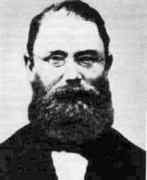◀ ▲ ▶History / 19th-century / Person: Clebsch, Rudolf Friedrich Alfred
Person: Clebsch, Rudolf Friedrich Alfred

Alfred Clebsch was a German mathematician worked on algebraic geometry and was a co-founder of Mathematische Annalen.
Mathematical Profile (Excerpt):
- Clebsch graduated from the Altstädtisches Gymnasium and entered the school of mathematics at the University of Königsberg in 1850.
- Although he never met Jacobi, who died one year after Clebsch entered the University of Königsberg, Jacobi was to influence him both through these two teachers and also directly through the fact that Clebsch was to collaborate in the production of the Collected Works of Jacobi.
- After graduating in 1854 Clebsch went to Berlin where he taught at various secondary schools.
- This was a fairly common route into the academic profession at this time and Clebsch had every intention of seeking a university post.
- Alfred and Dorothe Clebsch had four sons: Ernst Friedrich Alfred Clebsch (1859-1945); Arthur Friedrich Alfred Clebsch (1860-1931); Eduard Friedrich Alfred Clebsch (1861-1895), who became a medical doctor in Ems; and Alfred Friedrich Clebsch (1864-), who became a trader in Bremen in the firm Clebsch and Schünemann, Tobacco merchants.
- Now as we mentioned above, Clebsch's doctoral dissertation at Königsberg was on hydrodynamics and most of the papers he wrote while a school teacher were on topics mainly concerned with hydrodynamics and elasticity.
- To the Polytechnischen Schule, Clebsch brought many new ideas, perhaps the most significant of which was the establishment of the mathematical colloquia.
- Even before his appointment at Karlsruhe there had been signs of Clebsch moving towards pure mathematics with his work on the calculus of variations.
- Pure mathematics became Clebsch's main research topic when he began to study the calculus of variations and partial differential equations.
- Clebsch moved to the University of Giessen in 1863 and there he collaborated with Paul Gordan.
- The Clebsch-Gordan coefficients used in spherical harmonics were introduced by them as a result of this cooperation.
- Clebsch proved himself an outstanding teacher and combined his teaching skills with his research skills in building a school of algebraic geometry and invariant theory at Giessen which included Paul Gordan, Alexander Brill, Max Noether, Ferdinand von Lindemann and Jacob Lüroth.
- It was Otto Hesse who had advised Clebsch to investigate the algebraic geometry of Cayley, Sylvester and Salmon and he was particularly attracted to the contributions that Aronhold had made to their theories.
- Clebsch went back to Abel's approach to algebraic geometry and, rather than the geometric approach of Riemann.
- His interpretation of the works of Cayley, Sylvester and Salmon in this way led Clebsch to a brilliant new interpretation of Riemann's function theory.
- Clebsch, by taking as his starting-point an algebraic curve defined by its equation, made the theory more accessible to the mathematicians of his time, and added a more concrete interest to it by the geometrical theorems that he deduced from the theory of Abelian functions.
- In 1868 Clebsch was appointed to the University of Göttingen.
- Clebsch arrives at this result by considering double integrals belonging to the surface.
- It was just after Clebsch had produced these new ideas that Felix Klein arrived in Göttingen to undertake postdoctoral work with him.
- Clebsch's ideas were being rapidly extended by the other talented members of his school.
- After spending eight months working in Göttingen, Klein spoke to Clebsch about broadening his horizons and spending a semester in Berlin.
- Clebsch strongly advised him not to go to Berlin and Klein realised that there were serious tensions between the Göttingen school and the one in Berlin.
- However, he went against Clebsch's advice and spent a semester to Berlin.
- Sadly Clebsch's brilliant career came to a sudden end in 1872 when he died of diphtheria.
- A second edition of part of one of these volumes, with Clebsch as joint author, was published in three parts in 1906, 1910 and 1932.
- Clebsch described the plane representations of various rational surfaces, especially that of the general cubic surface.
- Clebsch must also be credited with the first birational invariant of an algebraic surface, the geometric genus that he introduced as the maximal number of double integrals of the first kind existing on it.
Born 19 January 1833, Königsberg, East Prussia (now Kaliningrad, Russia). Died 7 November 1872, Göttingen, Germany.
View full biography at MacTutor
Tags relevant for this person:
Algebra, Geometry, Origin Russia
Thank you to the contributors under CC BY-SA 4.0! 

- Github:
-

- non-Github:
- @J-J-O'Connor
- @E-F-Robertson
References
Adapted from other CC BY-SA 4.0 Sources:
- O’Connor, John J; Robertson, Edmund F: MacTutor History of Mathematics Archive
